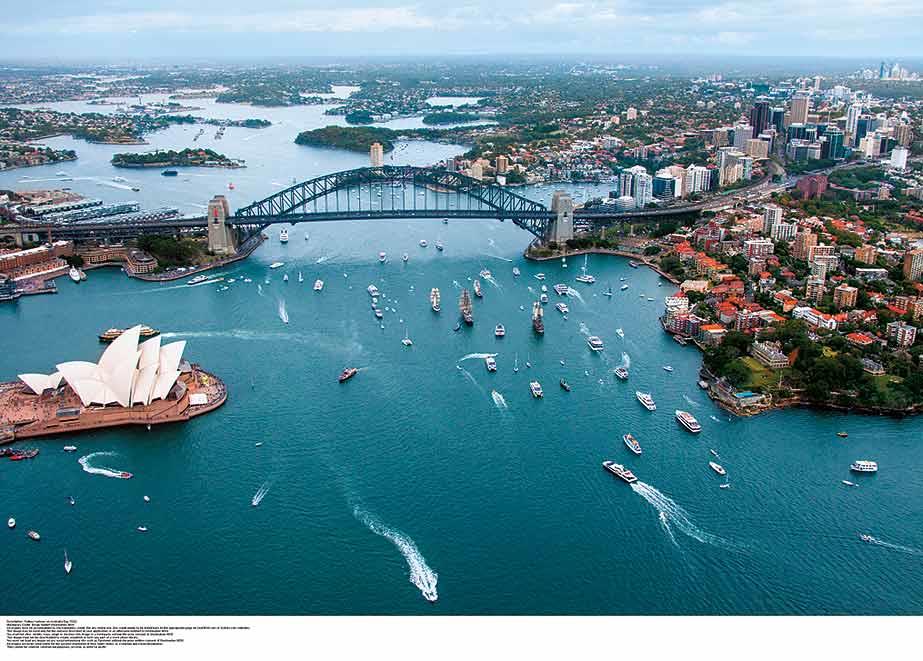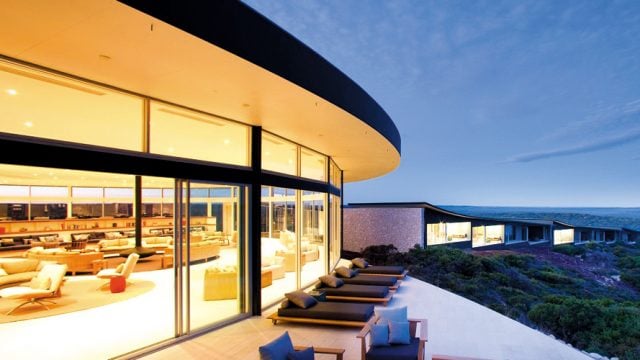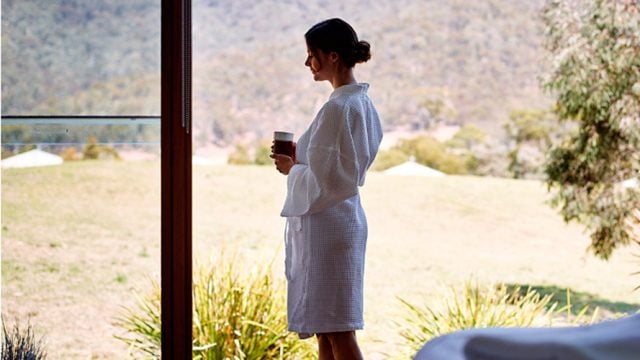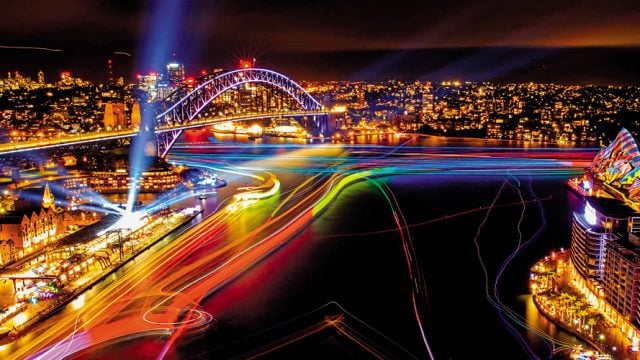There was I, minding my own small hotel business in the nearly-perfect paradise of Goa, wondering if
Well, of course I would. Australia was already living up to its reputation as ‘The Lucky Country’.
On the 12-hour Air India flight over, I felt as smug as a Tourist Board babu on his first foreign junket after a 12-year probation. I hadn’t been to Sydney since the mid-Eighties, and so it would be very interesting to see how things had changed. It must be said that an earlier view of the archetypal Aussie bloke went something like this piece of doggerel from those days by the Pom writer John Turnbull:
The Aussie Cobber 2
So narrow is his mind,
His ears very nearly touch.
So low-brow are his tastes,
His brains are in his crotch.
These days, you may be surprised to hear that one in three Sydneysiders was born outside the country, including over 200 nationalities. It’s not just cosmopolitan, it’s positively global.
The cityscape, in contrast, was always stunning, and the view of the harbour from my room on the 26th floor of the Shangri-La as mesmerising as I knew it would be. People sometimes liken the city to San Francisco without the Californians, but that doesn’t do it justice, since no other place in the world uses its harbour, beaches and ocean as beautifully as Sydney. And, of course, three hundred days of sunshine does help. This was the sunlit scene that presented itself to me from my hotel window. Unfortunately, I suffer from vertigo, and so couldn’t lie on the padded leather sills to really drink it in. I had to stand four feet away, swaying slightly and stumbling occasionally as my brain told my body that it was in mortal danger of plummeting through the thickened glass to the water below.
On our first day, we were met by one of the two charming Tourist Board Mistress-Minders, who whisked us off to lunch. Now, food is a cut-throat business in Sydney. They have ‘Hats’ instead of Michelin Stars here, and they seem to change around quite regularly. It must be very galling as a chef to lose a hat to some young upstart, on the whim of a prim reviewer. The upside of this is that the quality is consistently world-beating.
Both these factors were in play at Chiswick (pronounced without the ‘w’), where our appetites were healthy and my trousers still fitted.
The restaurant, in a bright Loggia set in a large garden in a leafy suburb close to the CBD, has at least a couple of claims to fame — one being its own kitchen garden, the other being that it is owned by the ubiquitous Matt Moran, a celebrity chef with several restaurants to his name, a kind of Aussie Ritu Dalmia. Don’t worry if you haven’t heard of him, I can assure you that in the words of an old Kiwi advertising slogan, he is ‘world-famous in Sydney’.
He has also just lost his hat.
I hope this doesn’t bother him too much. It certainly didn’t bother me. The food, wine and setting were all sublime in a ‘contemporary Australian cuisine’ sort of way. I stuck to my pre-trip resolutions of (i) choosing things that cannot be found in India, and (ii) being as adventurous as I could. This led me to scallops and a slow-cooked shoulder of lamb, which would have happily got a Top Hat from me.
As far as my jaded taste buds can tell, ‘contemporary Australian cuisine’ means tasty, beautiful-looking food that uses the freshest organic ingredients from passionate local growers, cooked with elegant simplicity and extraordinary attention to detail. Oh, and one other thing: it should be ‘unique’ or at the very least, ‘innovative’.
Australia’s most awarded chef, Neil Perry of Rockpool, has said, “I think we integrate Asia better than anywhere else in the world, unhindered by cultural ties and traditions… we are part of Asia, after all. For me, that is what sets us apart.”
This was certainly the case at popular Australian-Chinese chef Kylie Kwong’s restaurant Billy Kwong in the Surry Hills. She won this year’s ‘Award for Innovation’. She has gradually been introducing Australian native ingredients to her menu, what she calls ‘Chinese Bush Tucker’. Determined as I was to be adventurous, I tried her ‘crispy house cricket and prawn wontons’. Edible indigenous insects were a step too far for me, although for Kylie “it makes the notion of Australian-Chinese food more authentic and meaningful”.
Everything these days is described as ‘iconic’. I even read about an ‘iconic’ brothel (legal in Sydney). But don’t worry, we won’t, indeed we didn’t, go there. In reality, the truly iconic thing about Sydney is the Opera House, which never disappoints. You can’t take your eyes off it from a distance and its sheer power only increases as you get closer to this timelessly contemporary cathedral to culture (with both big and small c’s).
But I wouldn’t just do the usual tourist-as-herded sheep tour thing. Do your research and book something — anything — to see inside it. This is what Sydneysiders do, always happy to indulge in the pleasures of this most hedonistic of cities. Follow their lead and you’ll be greatly rewarded.
The story of how Danish architect Jørn Utzon first won the competition to design the Opera House and then fought to get it built, before being ignominiously sacked by a new wave of politicians and replaced by a bureaucratic ‘yes-man’ is the story of every creative genius’s fight against mediocrity.
If there is really nothing you want to see (and it is not all opera at all), one can at least just sit and stare at it while enjoying a very civilised oyster and glass of sauvignon from the Opera Kitchen on the waterside. It’s the perfect spot to gaze at this wonder of architecture. As one architect gushed: “The sun did not know how beautiful its light was until it was reflected off this building.”
The next day they (literally) pushed the flying boat out for us, which was fortunate, since you only ‘get’ the geography of Sydney and its 60-odd beaches from the air. Here, I overcame my fear of heights to soar above the city toward the best lunch venue of the holiday: Jonah’s on Whale Beach. It is on a cliff, with surfers off the sandy beach way below, where whales often put on a show in this ocean at the end of the world. They have bedrooms, too — perfect for a big romantic anniversary.
I defy anyone to sit on their impossibly picturesque verandah, toy with a bubbly glass of champagne — and not think of immigrating.
There are two easy trips to do from Sydney: the Hunter Valley for its vineyards (and restaurants) and the Blue Mountains for its views (and restaurants). We did the latter, and I was coaxed by my fellow writers — against my better judgement — on to ‘the steepest train ride in the world’. They clearly mistook my afore-mentioned vertigo for simple cowardice, although you, of course, will know differently. I endured that journey, but drew the line at the ‘Scenic Skyway’, with its ‘electro-sceniglass floor’ separating you from a 270m drop to the valley below. The ‘Three Sisters and Echo Point’ were just as beautiful viewed from a safe distance on solid ground.
I then surprised myself — and that better judgement of mine — by actually enjoying an educational 30-minute performance at the Waradah Aboriginal Centre and further found myself breaking the habit of a lifetime by joining in an aboriginal dance on stage accompanied by a didgeridoo. I danced the part of an itchy kangaroo. This was the nearest I got to a kangaroo, other than eating one, which I’m happy to report was delicious.
Assuming you don’t have spare days to trek through the mountains, I would highly recommend a Segway tour to take in the views. Segways are very clever, battery-driven, self-balancing two-wheelers that you stand on and steer by leaning. You can just imagine one swerving through the potholes in techie-type cityscapes such as Bangalore or Gurgaon. Unfortunately, I got overconfident on my Segway, accelerated over a tiny bump in the track, and had to jump off before the thing careered over the edge of the Blue Mountain, where it was fortunately stopped by trees three metres down. Luckily, no damage was done to man or machine, only pride, which often comes before a fall.
Just a two-hour drive back to Sydney for our last couple of days, and we were delivered to lunch at the — you guessed it — ‘iconic’ Bondi Beach. Here, the ubiquitous Matt Moran’s North Bondi Fish is not to be missed, though I did miss out on their ‘snow crab slider’. There are always a couple of things on every contemporary Australian menu that have to be translated. A slider is actually a one-bite hamburger style bun, in this case probably made with organic flour from Matt’s mother’s hand-grown, heirloom wheat. Equally delicious were my Sydney rock oysters, scallops, Moreton Bay bugs and seared tuna.
I had no time for shopping and missed the late opening night at The Museum of Contemporary Art in The Rocks overlooking the Opera House. But I did manage to squeeze in a memorable visit to The White Rabbit Gallery. Housed in an old Rolls Royce service depot, it contains the world’s most significant collection of Chinese Contemporary Art.
Really, this sums up Sydney to a T: a bubbling, cosmopolitan experience that’s not to be missed, because although the city is just as beautiful as I remembered it to be, it has grown up and been re-invented by its people into a wonderfully varied, international and multi-racial culture capital of the new world. The cab driver on my final journey happened to originate from Bombay. He explained why no one here feels like a minority: “Mate,” he said, with a broad Aussie accent, “we’re not just part of the culture here, we are the culture.”
The information
Getting there
Air India flies to Sydney and back (sometimes via Melbourne) every day of the week. Fares start at approximately Rs 62,000. Airlines like Qantas, Cathay Pacific, Malaysia, Singapore and Jet also offer competitive and convenient connections to Sydney.
Visa
Australia provides tourist visas for up to 12 months for A$130, processed by VFS at its branches across India (022-67866006; [email protected]; vfs-au-in.com).
Currency
1 Australian Dollar (A$) = Rs 56.3
Where to stay
We stayed at the luxurious and perfectly positioned Shangri-La Hotel (from A$250; shangri-la.com/sydney/shangrila), where all the rooms have wonderful harbour views. Chi, the spa, has an infinity bath, and the Blu Bar and Altitude Restaurant on the 36th floor are packed with locals and guests. In the Blue Mountains, we stayed at the Fairmont Resort (from A$235; fairmontre sort.com.au) with incredible views over the awe-inspiring Jamison Valley on one side and the Leura golf course on the other. We then moved closer to Sydney’s best-loved shops at the very comfortable Amora Hotel (from A$250; sydney.amorahotels.com). The Taj Group’s harbour-side Blue Hotel (from A$225; tajhotels.com) is also a good option for its luxury and location (at a walking distance from the Royal Botanic Gardens and downtown). Quality budget stays aren’t thick on the ground but you might find 1888 Hotel (from A$150; 8hotels.com) in the happening inner city suburb of Pyrmont, not far from the Darling Harbour, quite likeable for its charmingly restored and spiffy interiors.
What to see & do
See what’s on and book a performance at the Unesco-listed Sydney Opera House (sydneyoperahouse.com). Don’t miss Sydney’s many amazing art galleries. I went to the Art Gallery of NSW (artgallery.nsw.gov.au), which has one of the finest collections of international and Australian art in a heritage setting, and admission to the gallery and most of its exhibitions and events are free. I also visited the Museum of Contemporary Art (mca.com.au) with its rooftop sculpture garden and café at 140, George Street, The Rocks, the site of the arrival of the first fleet of convicts in 1788; they have free guided tours and talks every day. The White Rabbit Gallery (whiterabbitcollection.org) in Chippendale opened in 2009 and houses one of the world’s most significant collections of Chinese contemporary art. It hosts two completely new exhibitions a year.
Assuming you have a head for heights, travel on the world’s steepest train ride (scenicworld.com.au) in the Unesco-listed Blue Mountains. Follow this up with an interesting educational trip to the Waradah Aboriginal Centre (waradahaboriginalcentre.com.au). You have to be 11 or above to enjoy a Segway tour of the Blue Mountains (segwaytoursblue mountains.com.au). Also, see Sydney in high style from a seaplane (seaplanes.com.au).
Where to eat
Sydney’s many famous restaurants are top-notch experiences by themselves. We loved Chiswick (chiswickrestaurant.com.au), the casual dining ‘neighbourhood’ restaurant with a menu designed around its kitchen garden and meant for sharing. The Opera Kitchen (operakitchen.com.au) promises ‘Sydney’s finest food with the world’s best view’, and delivers! Jonah’s (jonahs.com.au) is as much a luxurious ocean retreat as a super-classy restaurant. Billy Kwong (kyliekwong.org), Kylie Kwong’s recreation of a Chinese eating house, surprises with its innovations, and most of them are pleasant. North Bondi Fish (northbondifish.com.au) takes its seafood very seriously to delicious effect. Sadly, we didn’t get to AKI’s (akisindian.com.au) at Wolloomooloo, which now has a hat-trick of hats plating up Indian fine dining. Try to fit in a three-hour cooking course (and lunch) at the Sydney Seafood School in the huge Sydney Fish Market (sydneyfishmarket.com.au).
N.B. No one seems to leave tips in Sydney as apparently everyone is perfectly well-paid.
Museum of Contemporary Art
Segway tour
Sydney





